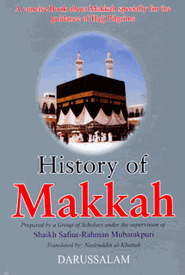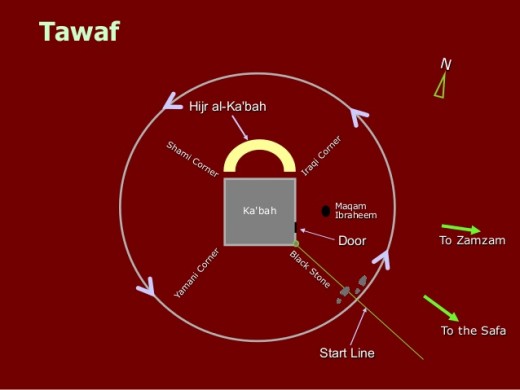Explanation Based on Shaykh Uthaymeen’s Tafseer
وَإِذْ جَعَلْنَا الْبَيْتَ مَثَابَةً لِّلنَّاسِ وَأَمْنًا وَاتَّخِذُوا مِن مَّقَامِ إِبْرَاهِيمَ مُصَلًّى ۖ وَعَهِدْنَا إِلَىٰ إِبْرَاهِيمَ وَإِسْمَاعِيلَ أَن طَهِّرَا بَيْتِيَ لِلطَّائِفِينَ وَالْعَاكِفِينَ وَالرُّكَّعِ السُّجُودِ
And (remember) when We made the House (the Ka’bah at Makkah) a place of resort for mankind and a place of safety. And take you (people) the Maqam (place) of Ibrahim (Abraham) [or the stone on which Ibrahim (Abraham) stood while he was building the Ka’bah] as a place of prayer (for some of your prayers, e.g. two Rak’at after the Tawaf of the Ka’bah at Makkah), and We commanded Ibrahim (Abraham) and Isma’il (Ishmael) that they should purify My House (the Ka’bah at Makkah) for those who are circumambulating it, or staying (I’tikaf), or bowing or prostrating themselves (there, in prayer).
[Qur’aan – Surah al-Baqarah 2:125]
Posted from: Tafseer – Explanation Surah Al-Baqarah – Dr Saleh as Saleh [Audio Series|En]. Explanation Based on Shaykh Uthaymeen’s Tafseer
The following has been posted from Tafseer Ibn Katheer (Darussalam English Publications):
The Virtue of Allah’s House
وَإِذْ جَعَلْنَا الْبَيْتَ مَثَابَةً لِّلنَّاسِ وَأَمْناً وَاتَّخِذُواْ مِن مَّقَامِ إِبْرَهِيمَ مُصَلًّى
125. And (remember) when We made the House (the Kabah at Makkah) a place of resort for mankind and a place of safety. And take you (people) the Maqam (place) of Ibrahim (or the stone on which Ibrahim as a place)
Al-Awfi reported that Ibn Abbas commented on Allah’s statement,
وَإِذْ جَعَلْنَا الْبَيْتَ مَثَابَةً لِّلنَّاسِ
(And (remember) when We made the House (the Kabah at Makkah) a place of resort for mankind)
“They do not remain in the House, they only visit it and return to their homes, and then visit it again.”
Also, Abu Jafar Ar-Razi narrated from Ar-Rabi bin Anas from Abu Al-Aliyah who said that,
وَإِذْ جَعَلْنَا الْبَيْتَ مَثَابَةً لِّلنَّاسِ وَأَمْناً
(And (remember) when We made the House (the Kabah at Makkah) a place of resort for mankind and a place of safety) means,
“Safe from enemies and armed conflict. During the time of Jahiliyyah, the people were often victims of raids and kidnapping, while the people in the area surrounding it (Al-Masjid Al-Haram) were safe and not subject to kidnapping.”
Also, Mujahid, Ata’, As-Suddi, Qatadah and Ar-Rabi bin Anas were reported to have said that the Ayah (2:125) means,
“Whoever enters it shall be safe.”
This Ayah indicates that Allah honored the Sacred House, which Allah made as a safe refuge and safe haven. Therefore, the souls are eager, but never bored, to conduct short visits to the House, even every year. This is because Allah accepted the supplication of His Khalil, Ibrahim, when he asked Allah to make the hearts of people eager to visit the House. Ibrahim said (14:40),
رَبَّنَا وَتَقَبَّلْ دُعَآءِ
(Our Lord! And accept my invocation).
Allah described the House as a safe resort and refuge, for those who visit it are safe, even if they had committed acts of evil. This honor comes from the honor of the person who built it first, Khalil Ar-Rahman, just as Allah said,
وَإِذْ بَوَّأْنَا لإِبْرَهِيمَ مَكَانَ الْبَيْتِ أَن لاَّ تُشْرِكْ بِى شَيْئاً
(And (remember) when We showed Ibrahim the site of the (Sacred) House (the Kabah at Makkah) (saying): “Associate not anything (in worship) with Me…”) (22:26) and,
إِنَّ أَوَّلَ بَيْتٍ وُضِعَ لِلنَّاسِ لَلَّذِى بِبَكَّةَ مُبَارَكاً وَهُدًى لِّلْعَـلَمِينَ فِيهِ ءَايَـتٌ بَيِّـنَـتٌ مَّقَامُ إِبْرَهِيمَ وَمَن دَخَلَهُ كَانَ ءَامِناً
(Verily, the first House (of worship) appointed for mankind was that at Bakkah (Makkah), full of blessing, and a guidance for Al-Alamin (mankind and Jinn). In it are manifest signs (for example), the Maqam (place) of Ibrahim; whosoever enters it, he attains security) (3:96-97).
The last honorable Ayah emphasized the honor of Ibrahim’s Maqam, and the instruction to pray next to it,
وَاتَّخِذُواْ مِن مَّقَامِ إِبْرَهِيمَ مُصَلًّى
(And take you (people) the Maqam (place) of Ibrahim as a place of prayer). The Maqam of Ibrahim Sufyan Ath-Thawri reported that Said bin Jubayr commented on the Ayah,
وَاتَّخِذُواْ مِن مَّقَامِ إِبْرَهِيمَ مُصَلًّى
(And take you (people) the Maqam (place) of Ibrahim as a place of prayer) “The stone (Maqam) is the standing place of Ibrahim, Allah’s Prophet, and a mercy from Allah. Ibrahim stood on the stone, while Ismail was handing him the stones (constructing the Kabah).”
As-Suddi said, “The Maqam of Ibrahim is a stone which Ismail’s wife put under Ibrahim’s feet when washing his head.”
Al-Qurtubi mentioned this, but he considered it unauthentic, although others gave it prefrence, Ar-Razi reported it in his Tafsir from Al-Hasan Al-Basri, Qatadah, and Ar-Rabi bin Anas.
Ibn Abi Hatim reported that Jabir, describing the Hajj (pilgrimage) of the Prophet said, “When the Prophet performed Tawaf, Umar asked him, Is this the Maqam of our father’ He said, Yes.’ Umar said, Should we take it a place of prayer’ So Allah revealed,
وَاتَّخِذُواْ مِن مَّقَامِ إِبْرَهِيمَ مُصَلًّى
(And take you (people) the Maqam (place) of Ibrahim (Abraham) as a place of prayer.”)
Al-Bukhari said, “Chapter: Allah’s statement,
وَاتَّخِذُواْ مِن مَّقَامِ إِبْرَهِيمَ مُصَلًّى
(And take you (people) the Maqam (place) of Ibrahim (Abraham) as a place of prayer) meaning, they return to it repeatedly.” He then narrated that Anas bin Malik said that Umar bin Al-Khattab said, “I agreed with my Lord, or my Lord agreed with me, regarding three matters. I said, O Messenger of Allah! I wish you take the Maqam of Ibrahim a place for prayer.’ The Ayah,
وَاتَّخِذُواْ مِن مَّقَامِ إِبْرَهِيمَ مُصَلًّى
(And take you (people) the Maqam (place) of Ibrahim (Abraham)) was revealed. I also said, O Messenger of Allah! The righteous and the wicked enter your house. I wish you would command the Mothers of the believers (the Prophet’s wives) to wear Hijab. Allah sent down the Ayah that required the Hijab. And when I knew that the Prophet was angry with some of his wives, I came to them and said, Either you stop what you are doing, or Allah will endow His Messenger with better women than you are.’ I advised one of his wives and she said to me, O Umar! Does the Messenger of Allah not know how to advise his wives, so that you have to do the job instead of him’ Allah then revealed,
عَسَى رَبُّهُ إِن طَلَّقَكُنَّ أَن يُبْدِلَهُ أَزْوَجاً خَيْراً مِّنكُنَّ مُسْلِمَـتٍ
(It may be if he divorced you (all) that his Lord will give him instead of you, wives better than you, ـ Muslims (who submit to Allah)).” (66:5)
Also, Ibn Jarir narrated that Jabir said, “After the Messenger of Allah kissed the Black Stone, he went around the house three times in a fast pace and four times in a slow pace. He then went to Maqam of Ibrahim, with it between him and the House, and prayed two Rakahs.” This is part of the long Hadith that Muslim recorded in Sahih. Al-Bukhari recorded that Amr bin Dinar said that he heard Ibn Umar say, “The Messenger of Allah performed Tawaf around the House seven times and then prayed two Rakahs behind the Maqam.”
All these texts indicate that the Maqam is the stone that Ibrahim was standing on while building the House. As the House’s walls became higher, Ismail brought his father a stone, so that he could stand on it, while Ismail handed him the stones. Ibrahim would place the stones on the wall, and whenever he finished one side, he would move to the next side, to complete the building all around. Ibrahim kept repeating this until he finished building the House, as we will describe when we explain the story of Ibrahim and Ismail and how they built the House, as narrated from Ibn Abbas and collected by Al-Bukhari. Ibrahim’s footprints were still visible in the stone, and the Arabs knew this fact during the time of Jahiliyyah. This is why Abu Talib said in his poem known as Al-Lamiyyah’, “And Ibrahim’s footprint with his bare feet on the stone is still visible.”
The Muslims also saw Ibrahim’s footprints on the stone, as Anas bin Malik said, “I saw the Maqam with the print of Ibrahim’s toes and feet still visible in it, but the footprints dissipated because of the people rubbing the stone with their hands.”
Earlier, the Maqam was placed close to the Kabah’s wall. In the present time, the Maqam is placed next to Al-Hijr on the right side of those entering through the door.
When Ibrahim finished building the House, he placed the stone next to the wall of Al-Kabah. Or, when the House was finished being built, Ibrahim just left the stone where it was last standing, and he was commanded to pray next to the stone when he finished the Tawaf (circumambulating). It is understandable that the Maqam of Ibrahim would stand where the building of the House ended. The Leader of the faithful Umar bin Al-Khattab, one of the Four Rightly Guided Caliphs whom we were commanded to emulate, moved the stone away from the Kabah’s wall during his reign. Umar is one of the two men, whom the Messenger of Allah described when he said,
«اقْتَدُوا بِاللَّذَيْنِ مِنْ بَعْدِي أَبِي بَكْرٍ وَعُمَر»
(Imitate the two men who will come after me: Abu Bakr and Umar.)
Umar was also the person whom the Qur’an agreed with regarding praying next to Maqam of Ibrahim. This is why none among the Companions rejected it when he moved it.
Abdur-Razzaq reported from Ibn Jurayj from Ata’, “Umar bin Al-Khattab moved the Maqam back.” Also, Abdur-Razzaq narrated that Mujahid said that Umar was the first person who moved the Maqam back to where it is now standing.” Al-Hafiz Abu Bakr, Ahmad bin Ali bin Al-Husayn Al-Bayhaqi recorded A’ishah saying, “During the time of the Messenger of Allah and Abu Bakr, the Maqam was right next to the House. Umar moved the Maqam during his reign.” This Hadith has an authentic chain of narration.





You must be logged in to post a comment.